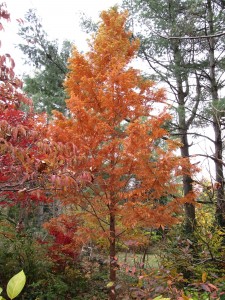Dawn redwood (Metasequoia glyptostroboides) was thought to be extinct for the past 20 million years. Since 1948 gardeners have witnessed its re-introduction back into the North American landscape from Sichuan-Hubei Provinces in China where the tree was re-discovered.
Dawn redwood prefers a well-drained, compost-rich, acidic soil. This deciduous conifer tolerates standing water for a brief 2-3 day span, not as long as bald cypress (Taxodium spp.). If the tree is left branched to the ground on an open site, the trunk often develops large, contorted “boles”.
Active spring/summer growth emerges bright green and the fine textured foliage quickly darkens up to medium green. Autumn foliage turns a tan to pinkish color, finishing reddish bronze before dropping.
The main trunk displays “arm pits”, depressed areas along the main trunk where the branches are attached. The trunk base flairs out at the surface of the ground. During the winter the tree’s leafless framework is easily identified by its straight butressed trunk, strong central leader and wide horizontal conical branching. Its shredded reddish brown bark is an added winter attribute.
Dawn redwood is rarely bothered by disease and pest problems. Spider mites may be problematic during long dry spells. Japanese beetles may consume some foliage, but the tree’s fast growth rate cosmetically repairs most of the damage incurred. Ultimately, dawn redwood grows to 80-100 feet tall and is best sited for large properties such as public parks, golf courses, and college campuses.
Gold Rush® (‘Ogon’) dawn redwood is a popular gold-leafed form. It grows slightly slower than the species, but eventually attains large tree status.


 Posted in
Posted in 
